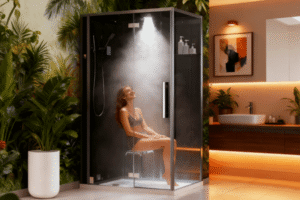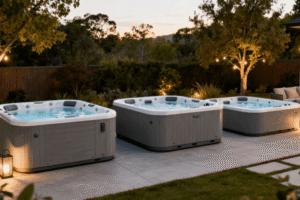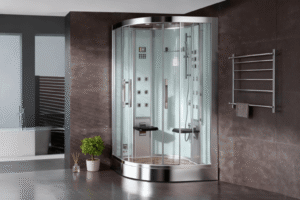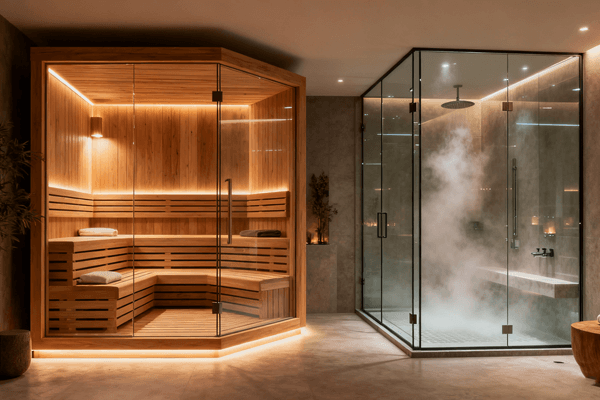
If you want deep relaxation but can’t decide between a sauna and steam room, this guide clears your confusion fast.
Saunas use dry heat1 while steam rooms use moist heat2. Each benefits your body differently and suits different lifestyles.
Both are powerful for wellness. Let’s explore which one truly fits your needs.
What Is a Sauna and How Does It Work?
A sauna uses dry heat, usually generated by wood, electricity, or infrared panels. It raises your body temperature, triggering sweat that helps detoxify3 and improve blood circulation4.
A sauna works by using dry heat to raise your body temperature, encouraging sweating that promotes relaxation and detoxification.
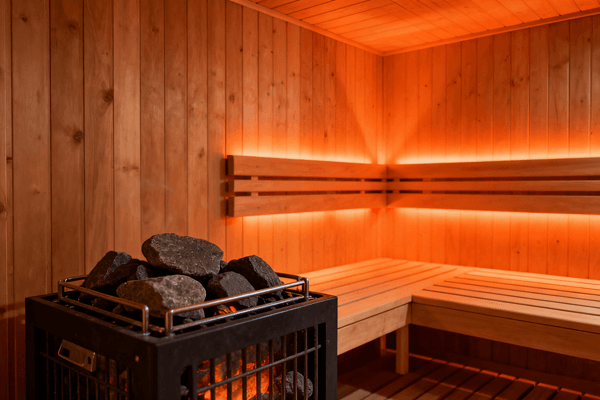
What Temperature Does a Sauna Typically Reach?
Most traditional saunas operate between 160°F and 200°F (70°C to 93°C). This heat deeply penetrates your muscles and releases stress quickly. Infrared saunas, a modern type, use lower temperatures but deliver similar benefits.
What Happens to Your Body During a Sauna Session?
When you sit inside a sauna, your heart rate rises, blood vessels dilate, and circulation improves. This process helps eliminate toxins through sweat and reduces muscle soreness. It’s a natural, passive form of cardio that boosts recovery.
What Are the Key Health Benefits of Using a Sauna?
The benefits include better circulation, improved metabolism, stress relief, and stronger skin elasticity. Some users also report better sleep and mental clarity after frequent use. Regular sessions can support your immune system too.
Is a Home Sauna Worth the Investment in 2025?
Absolutely. With wellness becoming part of home design trends, a home sauna increases property value and personal comfort. At Holie, we supply customizable saunas that fit residential and commercial spaces with low energy use and elegant design.
What Is a Steam Room and How Does It Work?
Steam rooms use moist heat from boiling water or steam generators. The air inside feels dense and humid, creating an environment ideal for respiratory and skin benefits.
Steam rooms produce moist heat that opens pores, improves breathing, and helps relax muscles after workouts.
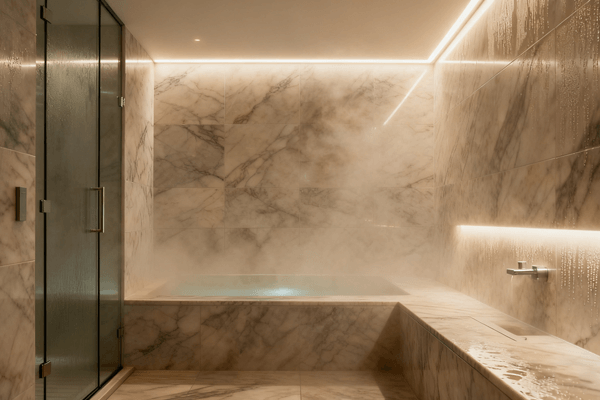
How Is a Steam Room Different from a Sauna?
The main difference is humidity. Saunas use dry heat, while steam rooms are fully humid, often reaching 100% humidity. The experience feels gentler on your body but heavier in air density.
What Are the Main Benefits of Steam Therapy?
Steam therapy helps hydrate skin, clear sinuses, and relieve joint pain. It also improves circulation and supports deep relaxation. Many wellness centers now combine steam therapy5 with aromatherapy for extra comfort.
Are Steam Rooms Good for Your Skin and Lungs?
Yes. The moist heat opens pores and cleanses skin impurities. It also soothes airways, making it ideal for people with mild respiratory issues. Regular use can enhance your natural glow and breathing quality.
Can You Install a Steam Room at Home Easily?
Modern steam generators make it possible. Holie’s steam shower units6 come with pre-installed systems and safety features. Installation only needs proper sealing, a water supply, and drainage connection.
Sauna vs Steam Room — What Are the Main Differences?
While both serve similar wellness goals, the heat type and body response differ significantly.
Saunas deliver dry heat7; steam rooms deliver moist heat. The choice depends on personal comfort, health goals, and home design.
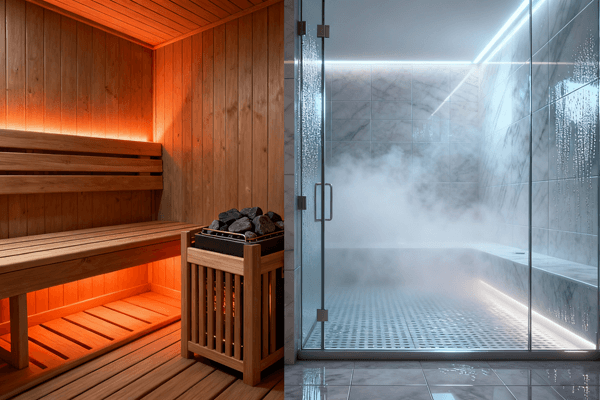
Which One Uses More Humidity and Heat?
Saunas rely on dry, intense heat; steam rooms use cooler but fully humid air. Dry heat makes you sweat faster, while humid heat8 feels softer on your skin and lungs.
Which Offers Better Detox or Weight Loss Benefits?
Both promote sweating and detoxification. Saunas burn slightly more calories because of higher heat levels, but steam rooms are better for hydration and skin detox.
Which Is Safer for Daily Use — Sauna or Steam Room?
Both are safe when used correctly. Beginners should limit sessions to 15–20 minutes. Always stay hydrated. People with heart or respiratory issues should consult a doctor before use.
Which One Saves More Energy and Space in Your Home?
Infrared saunas consume less power and require less space. Steam rooms need more energy for continuous steam generation. For compact home spas, a modern sauna might be more efficient.
What to Consider Before Choosing a Sauna or Steam Room
Your choice should depend on your goals, space, and budget.
Evaluate installation cost9, maintenance needs10, and personal preferences before investing in a wellness system.

What Are the Costs and Maintenance Differences?
Saunas usually cost less to maintain because they don’t need water connections. Steam rooms need sealing and regular descaling of the generator. Holie offers both systems with easy maintenance solutions for B2B and project clients.
| Type | Installation Cost (avg) | Maintenance Level | Energy Use |
|---|---|---|---|
| Traditional Sauna | $3,000–$6,000 | Low | Moderate |
| Steam Room | $5,000–$8,000 | Medium | High |
| Infrared Sauna | $2,500–$5,000 | Very Low | Very Low |
How to Decide Based on Available Space?
If your space is small, an infrared or corner sauna is ideal. For larger bathrooms or spas, a steam shower offers a luxurious and spacious feel. Customization with Holie makes both options fit your layout perfectly.
Which Option Is Better for Commercial or Home Projects?
Commercial spaces like gyms or hotels often prefer steam rooms for group sessions. Homeowners usually go for saunas due to lower maintenance and easier installation.
How Long Should Each Session Last for Best Results?
Experts recommend 15–20 minutes per session. Beginners should start with 10 minutes. Always cool down and rehydrate after use.
How to Use a Sauna or Steam Room Safely
Safety ensures you get the benefits without discomfort.
Follow temperature guidelines11, stay hydrated, and avoid using these systems if feeling unwell.

What’s the Correct Way to Prepare for a Session?
Shower first to remove oils or lotion. Bring a towel and water bottle. Enter once your body is clean and relaxed.
What Should You Avoid During Sauna or Steam Use?
Avoid alcohol, heavy meals, or staying too long. If you feel dizzy or overheated, exit immediately. Rest before taking another session.
How to Stay Hydrated12 and Maximize Recovery?
Drink water before and after sessions. Adding electrolytes helps restore minerals lost through sweat. Finish with a cold rinse to close pores and refresh circulation.
Sauna or Steam Room — Which One Should You Choose?
Choosing depends on what your body and lifestyle need most.
A sauna gives strong dry heat for deep muscle relief13; a steam room offers moist heat for skin and breathing comfort14.

Which One Fits Your Lifestyle and Health Goals?
If you value fast recovery, detox, and minimal upkeep, a sauna fits. If you prefer soft heat and skin therapy, a steam room is ideal. Business buyers can mix both for wellness resorts.
Should You Combine Both in Your Wellness Routine?
Yes. Many wellness centers install both systems to balance dry and moist heat therapy. Alternating sessions improve flexibility and recovery.
Final Verdict: Sauna vs Steam Room in 2025
In 2025, the best choice is the one that matches your wellness goals and space. For one-stop customized systems, Holie supplies both with high efficiency, easy installation, and global shipping.
Bonus — What’s Trending in Sauna and Steam Room Design (2025)
Wellness design is evolving fast with technology and sustainability.
Modern sauna and steam systems combine eco-efficiency15, smart control16, and design aesthetics.
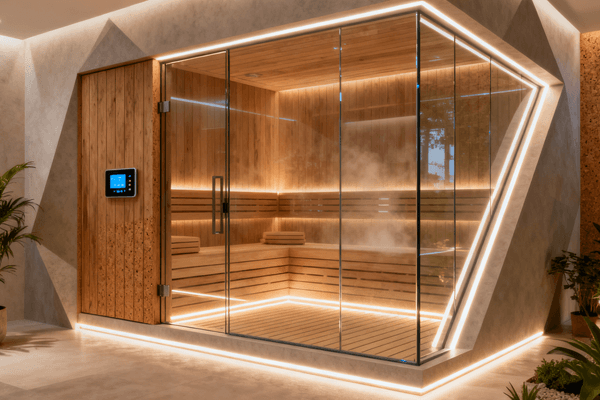
Are Infrared Saunas and Smart Steam Showers the Future?
Yes. Infrared technology cuts energy use by 40%. Smart steam showers allow digital temperature and aroma control. These trends lead 2025’s home spa innovations.
How Do Modern Wellness Brands Customize Sauna Cabins?
Custom materials, glass fronts, and Bluetooth lighting systems are popular. Holie supports OEM/ODM designs for global wellness projects and resort installations.
What’s the Global Demand Trend for Sauna and Steam Products?
The demand keeps rising in North America, Europe, and the Middle East. Hotels, spas, and private homes are driving the market. Buyers now prefer eco-friendly, smart-controlled wellness systems.
Conclusion
Both sauna and steam room offer effective ways to relax, detox, and improve health. Saunas provide strong dry heat that relieves muscles and reduces fatigue, while steam rooms add hydration and skin care. Choosing the right system depends on your lifestyle, space, and budget. In 2025, combining both systems becomes a growing trend for modern wellness and hospitality projects. Holie continues to support buyers with customized, energy-efficient sauna and steam solutions that match the latest global wellness trends.
-
Discover how dry heat can enhance your wellness routine and improve relaxation. ↩
-
Learn how moist heat can benefit your health and provide a soothing experience. ↩
-
Exploring this link will provide insights into how saunas aid in detoxification and overall health. ↩
-
This resource will explain the mechanisms by which saunas enhance blood circulation and its health benefits. ↩
-
Explore the benefits of steam therapy for skin and respiratory health, and discover how it can enhance your wellness routine. ↩
-
Learn about the installation process of steam shower units to enjoy the benefits of a steam room in your own home. ↩
-
Exploring this link will provide insights into how dry heat can enhance your sauna experience and overall wellness. ↩
-
This resource will help you understand the unique benefits of humid heat for skin hydration and respiratory health. ↩
-
Knowing the installation costs helps you budget effectively and choose the right option for your space and needs. ↩
-
Understanding maintenance needs is crucial for long-term satisfaction and cost-effectiveness in your wellness investment. ↩
-
Understanding temperature guidelines is essential for a safe experience. Check this resource for detailed information. ↩
-
Staying hydrated is crucial for safety and maximizing benefits in a sauna. Explore this link for expert tips. ↩
-
Explore this link to understand how dry heat can enhance muscle recovery and overall wellness. ↩
-
Discover the advantages of moist heat for skin health and respiratory relief, perfect for your wellness routine. ↩
-
Explore how eco-efficiency enhances wellness spaces while reducing environmental impact. ↩
-
Discover the advantages of smart control in creating personalized and efficient wellness environments. ↩





